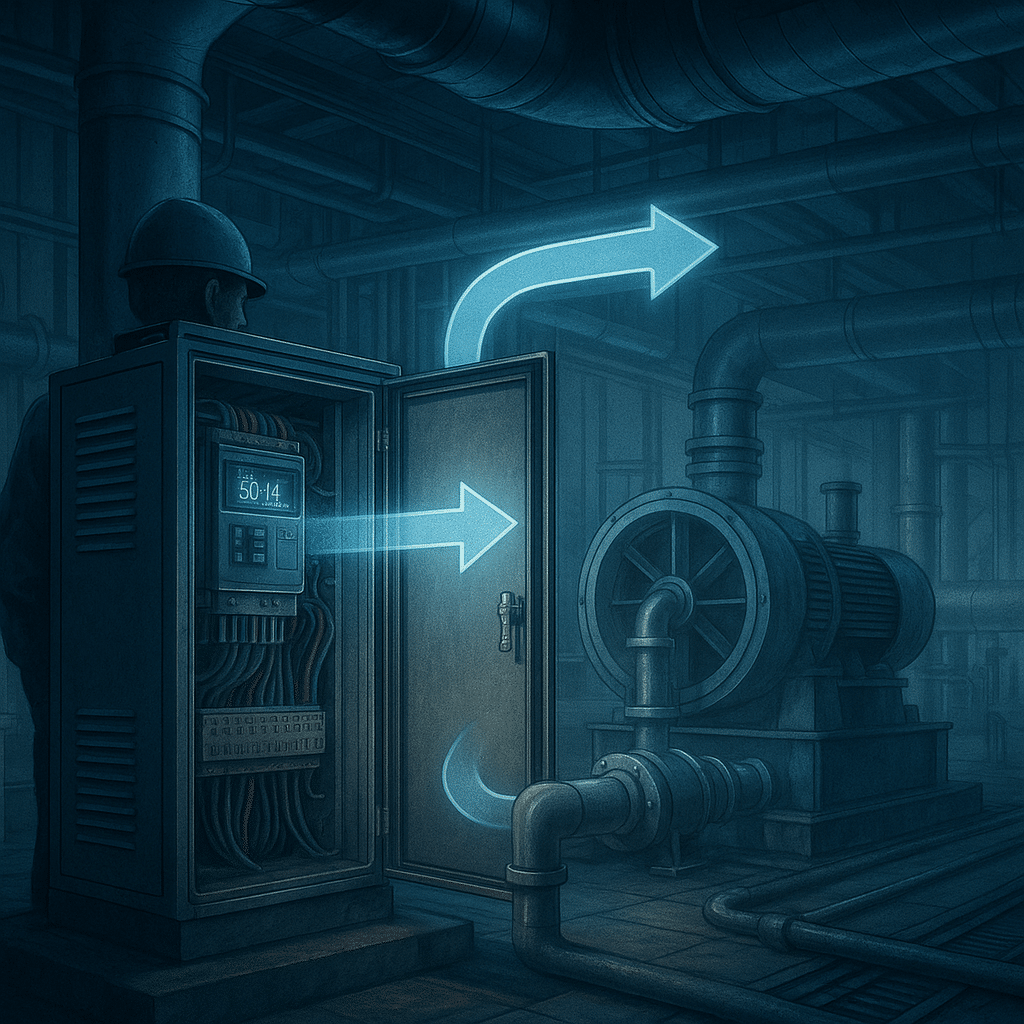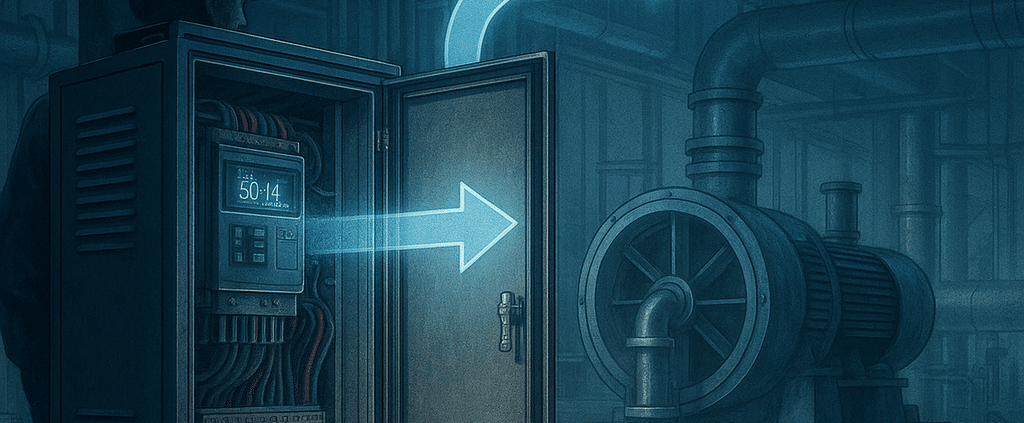Variable Frequency Drive HVAC: Ultimate Energy‑Saving Guide
Introduction
Heating, ventilation and air‑conditioning (HVAC) equipment routinely accounts for forty percent or more of a commercial building’s electricity bill. Consequently, engineers and facility managers continually pursue strategies that will trim energy consumption without compromising occupant comfort. Installing a variable frequency drive HVAC package on every major fan or pump has proven to be the single most effective step because the technology allows each motor to slow down whenever full speed is unnecessary. Moreover, slowing a fan by twenty percent can slash its power draw by roughly half, thanks to the well‑known fan affinity laws. Therefore, a modest investment in speed control unlocks outsized savings year after year.
Beyond lower utility costs, a modern VFD HVAC upgrade improves comfort, extends equipment life, and now satisfies mandatory provisions in energy codes such as ASHRAE 90.1. Throughout this guide we explain the physics behind the savings, identify common pitfalls, review best‑practice installation tips, compare leading manufacturer offerings, and highlight real‑world results. If you support an office tower, hospital, data center, or industrial plant, read on to learn how a HVAC VFD can turn wasted horsepower into hard cash.

Energy‑Saving Physics of Variable Frequency Drives in HVAC
When a squirrel‑cage induction motor is connected directly to the utility grid, it runs at a fixed synchronous speed—about 1,775 RPM for a four‑pole motor on sixty‑hertz power. However, a dedicated inverter inside a variable speed drive HVAC intercepts that fixed frequency, converts it to direct current, then re‑synthesizes a fresh alternating waveform at any frequency between near‑zero and the motor’s rated value. Because voltage rises proportionally with frequency, the motor produces its rated torque at every speed. Consequently, slowing a cooling‑tower fan to forty‑five hertz cuts power to roughly fifty‑five percent of nameplate while slashing acoustic noise.
Soft‑start functionality comes free with every adjustable frequency drive HVAC, which means inrush current never exceeds the motor’s full‑load amps. Therefore, transformers stop sagging, contactors last longer, and lights no longer flicker during startup. Because the drive ramps smoothly, mechanical shock on belts, couplings, and bearings disappears—another quiet form of savings. Utilities appreciate the lower demand spikes and often sponsor rebate programs that cover twenty to fifty percent of the installed cost. Consequently, payback periods of eighteen to thirty months are commonplace, even before maintenance savings enter the calculation.
Causes of Inefficiency and the Variable Frequency Drive Solution
Legacy constant‑speed control wastes energy in three distinct ways. First, bypass dampers or throttling valves shed excess air or water as load drops, a practice tantamount to driving with the brake depressed. Second, thermostatic cycling forces motors to start and stop repeatedly, producing electrical and mechanical stress while letting room temperatures drift. Third, across‑the‑line starts hammer shafts with six‑times rated current and torque. A HVAC variable speed drive resolves every issue elegantly. Because it modulates speed instead of blocking flow, dampers stay almost fully open, pump valves stay wide, and energy once lost as pressure drop turns into clean savings.
Furthermore, the integrated PID controller in most VFD for HVAC units maintains duct static pressure or loop differential pressure within tight bands. Consequently, spaces feel more stable, humidity control improves, and noise plumes in ductwork disappear. The drive’s diagnostics also record running hours, fault history, and kilowatt consumption, giving maintenance teams a data‑rich window into system health. Explore additional application notes in our industrial HVAC VFD resource.
Implementation Best Practices for HVAC VFD Projects
Successful projects begin with proper equipment selection. Always size the drive to at least 110 percent of the motor’s full‑load amperage, and verify the enclosure rating matches the installation environment. For example, Eaton’s PowerXL DH1 can survive ambient temperatures up to fifty °C, while ABB’s ACH580 supports a fire‑mode override recognized by UL 864. During commissioning, technicians should run automatic motor tuning, limit minimum frequency to preserve gearbox lubrication, and add a five‑percent input reactor when non‑linear loads dominate so total harmonic distortion meets IEEE‑519.
Moreover, program the variable frequency drive HVAC to communicate with the building automation system over BACnet IP or Modbus and trend key variables. Document every parameter and file it with the O&M manuals for future reference. For step‑by‑step guidance, review our VFD repair & commissioning checklist.

Comparing Leading HVAC Variable Frequency Drive Families
Manufacturers differentiate their HVAC portfolios in subtle yet important ways. Yaskawa’s Z1000 adds an onboard five‑percent line reactor and an EMI filter compliant with IEC 61800‑3. ABB pairs a bright graphical keypad with Bluetooth so technicians program drives outside the arc‑flash boundary, while Eaton refines Active Energy Control for an extra ten‑percent part‑load saving. Lenze packages its i500 in a footprint forty percent smaller than the prior generation, and Hitachi blends advanced sensor‑less vector control with a straightforward LCD in sizes up to 400 HP.
Because Precision Electric carries all major lines, we guide clients through lifecycle cost, harmonic performance, and service coverage before selecting the optimal variable frequency drive HVAC solution. Hospitals often prioritise Yaskawa’s redundant intelligent bypass, data centers value ABB’s ultra‑low total harmonic distortion, and K‑12 districts choose Eaton packages that include factory‑mounted disconnects—reducing field labour. Browse our stocked categories for quick ship options: ABB Drives, Yaskawa Drives, and Eaton Drives.
Real‑World Case Study and ROI
A national retail chain retrofitted 78 rooftop units with VFD HVAC kits supplied by Precision Electric. Engineers programmed supply fans to run at full speed during peak cooling but drop to fifty percent during ventilation. Moreover, each store reported quieter aisles and tighter temperature control. Twelve months of utility data revealed a 52 percent drop in HVAC energy use—7.2 million kWh and $888 k in savings—with a simple payback of 1.8 years. The project prevented 11 million lb of CO₂ annually.
Universities, hospitals, and industrial campuses echo these results, routinely posting 30–60 percent reductions after deploying a variable frequency drive HVAC or its synonym. Consequently, programs like TVA EnergyRight now pay incentives up to $100 per motor horsepower to accelerate adoption.
Conclusion & Next Steps
Variable frequency drives have evolved from niche equipment to indispensable building blocks. They deliver instant energy savings, precision environmental control, and longer mechanical life while helping facilities comply with ever‑stricter codes. Therefore, organisations that still run constant‑speed motors leave money on the table—and may violate code. Precision Electric stocks hundreds of units, offers 24‑hour repair service, and can ship a fully programmed variable frequency drive HVAC within days.








